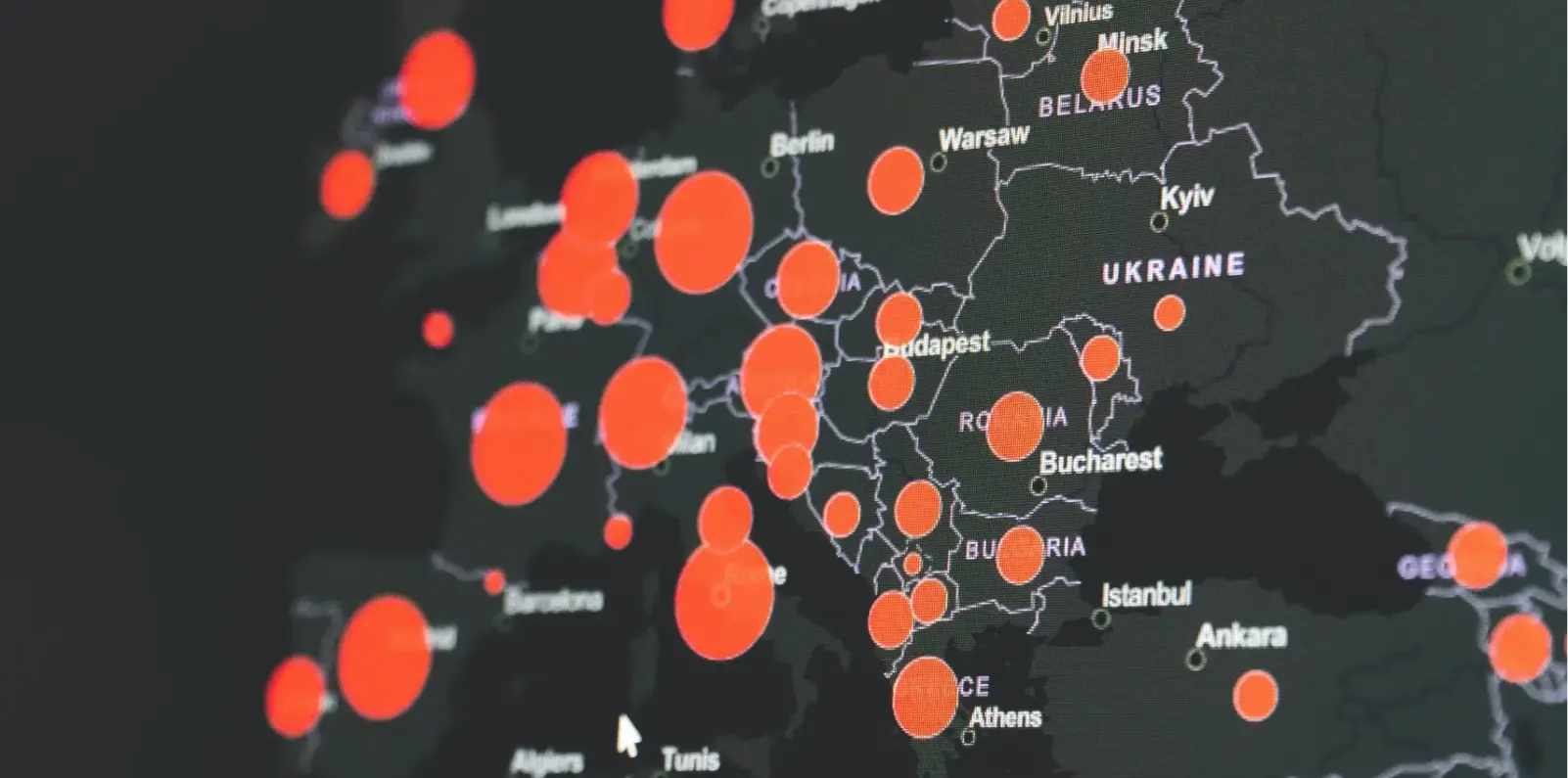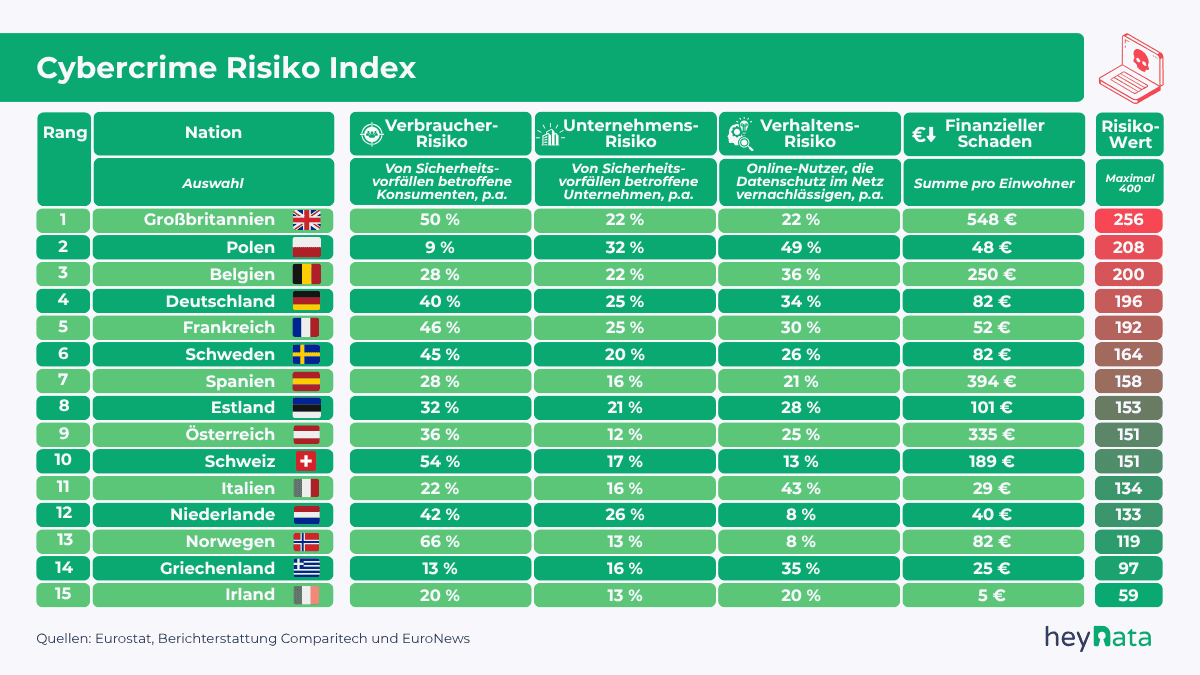
Cybercrime Risk Ranking: Potential Threats in Europe

Analysis shows potential threats to consumers and businesses in 15 European countries
Cybercrime – A European Risk With Real Consequences
Cyber attacks are no longer an exception – they are part of everyday digital life and affect millions of private individuals every year. Phishing, data theft and malware are among the most common forms of attack. At the same time, companies are increasingly being targeted by professional hackers. The impact is considerable – both for private individuals and for the economy.
A cross-national evaluation shows just how severe the impact already is: in the 15 European countries surveyed, the estimated damage caused by cyber attacks amounts to a total of around 80 billion euros.
But which countries are particularly affected – and why? Where are structural weaknesses evident, for example in the behavior of users or in the security situation of companies? The analysis answers these questions with the help of publicly available data.
Data Basis: Four Perspectives on the Cybercrime Risk
- Consumer risks: Consumers are frequently affected by security-related incidents when surfing, communicating or shopping online – for example through phishing, malware or fraud.
- Corporate risks: Companies are regularly confronted with IT security incidents – for example due to data loss, system malfunctions or unauthorized access.
- Behavioral risks: Risky user behavior increases susceptibility to cyber attacks – for example through insecure passwords, missing software updates or inadequate data protection measures.
- Financial damage: The estimated economic damage per capita caused by cyberattacks – for example through business interruptions, data loss or ransom demands.
The results from these four areas were combined in a weighted overall ranking. This was based on comparable and publicly available data that enables a comprehensible assessment of the risks per country. The higher the scores in the individual categories, the greater the overall risk – and the more vulnerable a country is to cyber attacks.

Cybercrime Risks in a European Comparison
The Cybercrime Risk Index shows how differently European countries are affected by digital threats. Technical weaknesses, insufficient education and risky user behavior are decisive risk factors.
Germany occupies a worrying 4th place in the Cybercrime Risk Index, which indicates a combination of aggressive attacks and risky user behavior. The risk of becoming the target of a cyberattack here is significantly higher than the European average.
Austria (9th place) and Switzerland (10th place) perform slightly better, but show their own risk patterns. Austria, for example, records particularly high financial losses of around 335 euros per inhabitant, which indicates increasing economic pressure from cyber attacks.
Digital Vulnerability Increases the Risk
Private consumers in Germany are particularly frequently affected by cyber attacks. Around 40% of consumers were recently the target of an attack, which is a comparatively high figure in a European comparison.
Consumers are even more affected in Switzerland, where more than one in two consumers (54%) were recently affected by cyber attacks. In Austria, this figure is 36%.
A key reason for these high figures could be the combination of prosperity and high internet usage in all three countries. This creates favorable conditions for cyberattacks.
In addition, despite a high level of internet literacy, many users here also lack a consistent security routine in everyday life.
This is also reflected in the behavioral risk: 34% of German consumers are demonstrably careless with their personal data, disclosing sensitive information via unsecured connections or storing it on insecure platforms. In Austria, the proportion of negligent users is 25%, compared to just 13% in Switzerland. This demonstrates a high level of media and digital literacy. This makes Switzerland one of the most security-conscious countries in Europe.
What We Learn:
- Germany, Austria and Switzerland are attractive targets for cyber criminals.
- Consumers have valuable data - and are often poorly protected.
- Security behavior remains patchy despite digital literacy.
- One in three Germans and one in four Austrians are careless with sensitive data.
- Swiss consumers are excessively frequent targets of cyberattacks, but mitigate their risk with good digital skills.
The Risks for SMBs
Companies in Germany are also increasingly being targeted by cyber criminals. One in four companies (25%) recently reported security-related IT incidents. This means that Germany is also one of the countries with an increased risk in a European comparison. In Switzerland, this figure recently stood at 17%.
At 12%, Austria has a low proportion of companies reporting IT security incidents. This is actually the lowest figure in the whole of Europe. This figure could indicate effective cyber security measures and a strong security culture that successfully fends off or minimizes attacks. Systematic risk management and regular training could also help to reduce cyberattacks.
On the other hand, a low reporting rate could also be due to conservative IT usage or undetected incidents. This value should therefore be interpreted with caution and considered in the context of further investigations.
In all three countries, SMEs are particularly frequently affected. Small and medium-sized enterprises (SMEs) often have sensitive customer data, intellectual property or payment information, but are often not secured to the same extent as large companies. Specialized IT security structures and regular risk analyses are lacking in many places.
This results in a rewarding target profile for attackers: high economic relevance with limited defenses. In addition, many SMEs are internationally networked and part of larger supply chains. This is an additional incentive for attacks aimed at compromising entire systems.
The most important findings:
- One in four German companies are affected by IT security incidents.
- These figures are lower in Switzerland and Austria, but the risk is still present.
- According to the data, Austrian companies are the least likely to be attacked.
- SMEs in particular offer a dangerous combination of valuable data and weak defense structures.
- International networking makes SMEs in the DACH region even more vulnerable.
This Is How Expensive Cyberattacks Are
The financial damage caused by cyberattacks varies significantly in the DACH region. At around 335 euros per capita, Austria has the highest per capita losses, followed by Switzerland with around 189 euros. Germany is significantly lower at around 82 euros per capita, although the absolute total losses in Germany are the highest at around 7 billion euros. Total losses in Austria amount to around 3 billion euros, in Switzerland to around 1.6 billion euros.
These differences can only partly be explained by population size. The higher per capita losses in Austria and Switzerland are more indicative of individual serious incidents. However, a precise assessment requires detailed data on the type and extent of individual attacks.
Great Britain: High Risks for Consumers and Companies
According to the Cybercrime Risk Index, the UK is particularly at risk. One in two British consumers has recently been the victim of phishing or other online attacks. Businesses are also affected: More than one in five report IT security incidents. This illustrates the tense security situation in the country. The financial losses amount to around 548 euros per inhabitant and reflect the seriousness of the situation.
Several factors contribute to this high risk: The UK's strong digitalization creates a large attack surface. British companies and consumers are internationally networked and therefore exposed to a wide range of threats. In addition, many cybercrime organizations specifically focus on the English-speaking market.
Brexit may have further exacerbated the situation. The associated regulatory uncertainty and changes in data protection and security requirements present companies with new challenges. In addition, the change in cooperation with EU institutions may make coordination in the area of cyber defense more difficult.
Key facts:
- In the UK, cybercrime causes economic damage of around 548 euros per inhabitant.
- Criminals prefer to attack English-speaking markets.
- Brexit could have brought additional security-related challenges for companies.
Ireland: The Country With the Lowest Cybercrime Risk
Ireland has the lowest cybercrime risk score in the analysis. The most recent financial losses amounted to just 24 million euros, which corresponds to a loss of around 5 euros per inhabitant. Despite the English-speaking market, only 13% of companies reported security incidents. However, one in five consumers occasionally neglects personal security precautions on the Internet.
This comparatively low exposure is likely due to effective cyber defenses, a strong security culture and targeted prevention measures. Ireland may also benefit from a robust regulatory environment that reduces the risk.
Recommendations and Conclusions
Given the huge financial impact of cyber-attacks, both businesses and consumers should take proactive measures. It is crucial for companies to develop a robust IT security strategy, conduct regular risk analyses and train their employees in cyber security. The SMB sector in particular needs targeted support to strengthen its defences and minimize the risk of attacks.
In light of the AI boom and the increasing use of automated, AI-assisted attacks by cybercriminals, companies urgently need to upgrade their digital defense strategies. These modern attacks also allow less tech-savvy hackers to launch successful attacks with little effort, further increasing the threat.
Consumers should also improve their digital security routines, such as using stronger passwords, two-factor authentication and regularly reviewing their security measures. The high number of attacks on private end users, especially in countries like Germany, urgently requires a shift in awareness towards more caution and prevention.
Policy makers are called upon to further improve cyber security standards and work closely with companies and international partners to increase cyber defense at all levels.
Sources Used and Ranking:
- Consumer risk: EuroStat: Consumer experiencing security-related incidents
- Enterprise risk: EuroStat: Security incidents and consequences by size class of enterprise
- Behavioral risk: EuroStat: Privacy and protection of personal data, Euronews: Data security: Which EU countries protect themselves the most?
- Financial damage: comparitech: Cybercrime victims lose an estimated $714 billion annually, eigene Berechnungen
- Ranking: To create the ranking, the results of the risk factors examined were standardized. A point scale from 0 to 100 was used for each factor: The state with the highest risk received 100 points, the state with the lowest risk 0 points. The normalization was carried out according to the following formula: x new = x - x minx max - x min. The normalized point values of all influencing factors were then added together. A maximum of 400 points could therefore be achieved. The higher the total value, the higher the position in the ranking.


